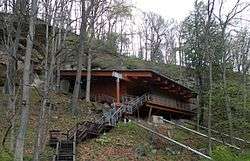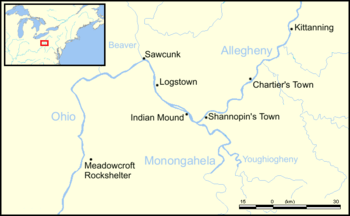Meadowcroft Rockshelter
|
Meadowcroft Rockshelter | |
 | |
  | |
| Location | Jefferson Township, Washington County, Pennsylvania, USA |
|---|---|
| Nearest city | Avella, Pennsylvania |
| Coordinates | 40°17′11″N 80°29′30″W / 40.28639°N 80.49167°WCoordinates: 40°17′11″N 80°29′30″W / 40.28639°N 80.49167°W |
| Area | 0.2 acres (0.081 ha) |
| NRHP Reference # | 78002480[1] |
| Significant dates | |
| Added to NRHP | November 21, 1978 |
| Designated NHL | April 5, 2005[2] |
| Designated PHMC | September 19, 1999[3] |
Meadowcroft Rockshelter is an archaeological site located near Avella in Jefferson Township, Washington County, Pennsylvania, United States. The site, a rock shelter in a bluff overlooking Cross Creek (a tributary of the Ohio River), is located 27 miles west-southwest of Pittsburgh[4] in the Pittsburgh metropolitan area. In the 21st century, the site has a museum and a reconstruction of a circa 1570s Monongahela Culture Indian village. It operates as a division of the Heinz History Center of Pittsburgh. The artifacts from the site show the area may have been continually inhabited for more than 19,000 years, since Paleo-Indian times.
The remarkably complete archaeological site shows the earliest known evidence of human presence and the longest sequence of continuous human occupation in the New World.[3]
It is also recognized as a Pennsylvania Commonwealth Treasure and is an official project of Save America's Treasures.
Etymology
Meadowcroft was named for the nearby Meadowcroft Rockshelter and Historic Village museum. Although sometimes referred to as "Meadowcroft Rock Shelter", the more accepted and popular term is "Meadowcroft Rockshelter".
Site
The rockshelter is a natural formation beneath an overhanging cliff of Morgantown-Connellsville sandstone, which is a thick Pennsylvanian-age sandstone, brown in color. Meadowcroft is in the Allegheny Plateau, northwest of the Appalachian Basin.[5]
The site was listed on the National Register of Historic Places in 1978. In 1999 , the Pennsylvania Historical and Museum Commission installed a historical marker noting the historic importance of the site.[3] It was designated a National Historic Landmark in 2005.[2] It is designated as a historic public landmark by the Washington County History & Landmarks Foundation.[6]
Archaeology

Native Americans left the site during the American Revolutionary War. It was not re-discovered until many years later, when, in 1955, Albert Miller found the first artifacts in a groundhog burrow. Miller delayed reporting his findings until he contacted James M. Adovasio, who led the first excavations of the site in 1973 until 1979 by the Cultural Resource Management Program of the University of Pittsburgh. Further University of Pittsburgh field school excavations were conducted through 1989.[7][8] Since the 1990s, more recent work has also been undertaken by Adovasio through the Mercyhurst Archaeological Institute.[9] The methods of excavation used at Meadowcroft are still seen as state-of-the-art. It is viewed as one of the most carefully excavated sites in North America.[10]
Radiocarbon dating of the site indicated occupancy beginning 16,000 years ago and possibly as early as 19,000 years ago. The dates are still controversial. A recent survey carried out by the Society for American Archaeology reported support from 38% of archaeologists, with 20% rejecting the early dates.[11] Criticism of these early radiocarbon dates has focused on the potential for contamination by ancient carbon from coal-bearing strata in the watershed.[12] The samples, tested by an independent third party geomorphologist, concluded that the samples showed no evidence of groundwater activity. Tests performed via accelerator mass spectrometry also support the earlier dates.[13] If authentic, these dates would indicate that Meadowcroft was used in the pre-Clovis era and, as such, provides evidence for very early human habitation of the Americas.[14][15] Meadowcroft Rockshelter may be the oldest known site of human habitation in North America, providing a unique glimpse into the lives of prehistoric hunters and gatherers. Paleoindian, Archaic, and Woodland remains have all been found at the site.
Meadowcroft Rockshelter has yielded the largest collection of flora and fauna materials ever recovered from a location in eastern North America.[16] The arid environment provided the necessary and rare conditions that permitted excellent botanical preservation. In total, animal remains representing 149 species were excavated. Evidence shows that people gathered smaller game animals as well as plants, such as corn, squash, fruits, nuts and seeds.
Additionally, the site has produced Pre-Clovis remains, found as deep as 11.5 feet underground. The site also has yielded many tools, including pottery, bifaces, bifacial fragments, lamellar blades, a lanceolate projectile point, and chipping debris. Recoveries of note also include fluted points, which are a marker of the Paleoindian period. Remains of flint from Ohio, jasper from eastern Pennsylvania and marine shells from the Atlantic coast suggest that the people inhabiting the area were mobile and involved in long-distance trade. At least one basin-shaped hearth was reused over time.
The Miller complex
An unusual type of arrowhead was found at the site, that has been named as the Miller Lanceolate projectile point. Similar unfluted lanceolate points have also been found at the adjacent sites.
"Enough lithic artifacts were recovered to define the Miller complex. This complex consists of thin bifaces, including one lanceolate point, the Miller Lanceolate; small prismatic blades; retouched flake tools and blades; and debitage related to latestage core and biface reduction and tool kit maintenance.
The Miller complex is further defined by surveys done in the Cross Creek watershed, where other lanceolate points, small prismatic blades, and small polyhedral blade cores have been recovered. According to Adovasio et al,[17] this complex has a Eurasiatic and Siberian appearance. These authors also note that small blades and polyhedral cores are absent from subsequent Paleoindian fluted-point assemblages in this region, reinforcing the technological distinctiveness of the Miller complex.[18]
The adjacent Krajacic Site is located about 10 miles southeast of Meadowcroft, and it is also important in defining the Miller complex. This site yielded a great variety of the distinctive Meadowcroft-style blade implements and several small, cylindrical polyhedral cores.
At Cactus Hill in Virginia, similar points have been found, where they are dubbed as the Early Triangular type. Some similar finds were made at the Page-Ladson prehistory site in Florida as well.
Because of the very long occupational sequence at Meadowcroft, it became a very important site, and is seen as quite valuable for comparative analysis.
"The Pre-Clovis artifacts from Meadowcroft Rockshelter include a lanceolate point (named the Miller Lanceolate), bifaces, unifaces, prismatic blades, core fragments, and debitage. Remains from other Pre-Clovis sites (e.g., Cactus Hill and Saltville, Virginia, Topper, South Carolina, etc.) are usually compared to the Meadowcroft assemblage.[19] In addition, claims for Pre-Clovis inhabitants in other sections of the New World also are evaluated with Meadowcroft in mind (Lozano Ruiz 2000)."[20]
According to some scholars, Clovis, Folsom and other fluted point complexes may have derived from such unfluted lanceolate points.
Current site
Renovations to the rock shelter in 2008 were made so that visitors can see some of the tools and campfires made by the first Americans thousands of years ago. The Rockshelter is recognized as a Pennsylvania Commonwealth Treasure and is an official project of Save America's Treasures. A recreation of a 17th-century Native American village is under development.
See also
- Prehistory of West Virginia
- List of Native American archaeological sites on the National Register of Historic Places in Pennsylvania
- Monte Verde
- Topper (archaeological site)
Citations
- ↑ National Park Service (2009-03-13). "National Register Information System". National Register of Historic Places. National Park Service.
- 1 2 "Meadowcroft Rockshelter". National Historic Landmark summary listing. National Park Service. Retrieved 2008-07-02.
- 1 2 3 "Meadowcroft Rockshelter - PHMC Historical Markers". Historical Marker Database. Pennsylvania Historical & Museum Commission. Retrieved December 8, 2013.
- ↑
- ↑ Meadowcroft Rockshelter, Mercyhurst Archeological Institute. Mercyhurst College. Erie, PA. Retrieved 2010-03-05.
- ↑ "Meadowcroft Rock Shelter". Landmark Registry - Public Landmark. Washington County History & Landmarks Foundation. 2008. Retrieved 2010-11-08.
- ↑ "Rockshelter". Heinz History Center. Retrieved February 3, 2013.
- ↑ Adovasio, J.M.; Donahue, J.; Stuckenrath, R. (April 1990). "The Meadowcroft Rochshelter Radiocarbon Chronology". American Antiquity. 55 (2): 348–354. doi:10.2307/281652. Retrieved February 3, 2013.
- ↑ McConaughy, Mark (April 15, 2004). "National HIstoric Landmark Nomination: Meadowcroft Rockshelter" (PDF). p. 5. Retrieved February 3, 2013.
- ↑ Templeton, David (October 15, 2000). "David Templeton's Seldom Seen: Meadowcroft still ignites controversy over settlers". Pittsburgh Post-Gazette. Retrieved February 3, 2013.
- ↑ Ancient Pa. Dwelling Still Dividing Archaeologists
- ↑ Tankersley, Kenneth B.; Munson, Cheryl Ann (April 1992). "Comments on the Meadowcroft Rockshelter: Radiocarbon Chronology and the Recognition of Coal Contaminants". American Antiquity: 321–326. Retrieved November 28, 2013.
- ↑ http://www.sfu.museum/journey/an-en/postsecondaire-postsecondary/meadowcroft. Missing or empty
|title=(help) - ↑ Sturdevant, Jay T. (January 1, 1999). "Still an Open Book: Analysis of the Current Pre- Clovis vs. Clovis Debate from the Site of Meadowcroft Rockshelter, Pennsylvania and Monte Verde, Chile". Nebraska Anthropologist: 31–38. Retrieved February 3, 2013.
- ↑ Adovasio, J.M.; Donahue, J.; Pedler, D.R.; Stuckenrath, R. (1998). "Two Decades of Debate on Meadowcroft Rockshelter". American Archaeologist. 19 (4): 317–341. doi:10.2190/1636-pbkv-n0nc-q11h. Retrieved February 3, 2013.
- ↑ Heinz History Center: Rockshelter Artifacts, Heinz History Center. Pittsburgh, PA. Retrieved 2010-10-17.
- ↑ Adovasio, J. M., D. Pedler, J. Donahue, and R. Stuckenrath (1999), No Vestige of a Beginning nor Prospect for an End: Two Decades of Debate on Meadowcroft Rockshelter. In Ice Age Peoples of North America: Environments, Origins, and Adaptations of the First Americans, edited by R. Bonnichsen and K. L. Turmire, pp. 416–31. Oregon State University Press, Corvallis. p.418
- ↑ Goodyear, Albert C. (1 January 2005). "Evidence of Pre-Clovis Sites in the Eastern United States". Scholar Commons. University of South Carolina. Retrieved 20 January 2015.
- ↑ Goodyear 2001; McAvoy and McAvoy 1997; Standford and Bradley 2002:259-260
- ↑ Meadowcroft - Significance of Property www.nps.gov
References
- Goodyear, Albert C. (1 January 2005). "Evidence of Pre-Clovis Sites in the Eastern United States". Scholar Commons. University of South Carolina. Retrieved 20 January 2015.
- Minnesota State University emuseum
- James Adovasio and Jake Page, The First Americans: In Pursuit of Archaeology's Greatest Mystery, 2003, ISBN 0-375-75704-X.
- Meadowcroft Rockshelter and Museum of Rural Life
- "The Greatest Journey," James Shreeve, National Geographic, March 2006, p. 64. Shows dates 19,000 to 12,000 years ago; as well as Clovis (13,500 years ago) and Monte Verde 14,800 years ago.
- Heinz History Center
Further reading
- Senator John Heinz Pittsburgh Regional History Center page on Meadowcroft Rockshelter
- Pittsburgh Post-Gazette article on Meadowcroft expert
- American Indian Village reenactment
- Adovasio, J. M., with Jack Page. The First Americans: In Pursuit of Archaeology's Greatest Mystery. New York: Random House, 2002. Chapter 7 focuses on the Meadowcroft Rockshelter; the rest of the book sets the dig and the controversy surrounding it in a broader scholarly context.
- Adovasio, J.M., J. Donahue, and R. Stuckenrath. "The Meadowcroft Rockshelter radiocarbon chronology 1975-1990." American Antiquity, 55.n2 (April 1990): 348(7).
- Chandler, Graham. “The dawn of civilization.” Equinox, 96 (1998): 18. A brief article about the site and its artifacts.
- Shea, Neil. “The First Americans?.” National Geographic, 207.5 (2005): 2.
- "Who's Really on First?", Natural History, 109.9 (Nov 2000): 10. Presents differing opinions between James Adovasio and Anna Curtenius Roosevelt regarding the accuracy of dating artifacts from Meadowcroft.
External links
| Wikimedia Commons has media related to Meadowcroft Rockshelter. |
- Meadowcroft Rockshelter at Pittsburgh History
- "America's Stone Age Explorers". NOVA. PBS TV. Retrieved 2006-06-01.


